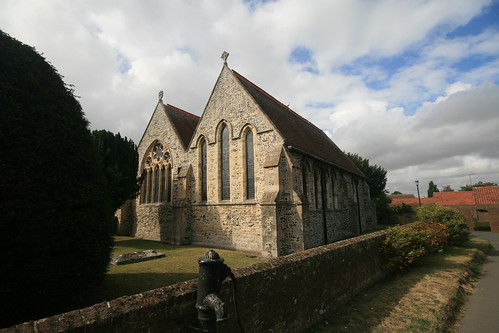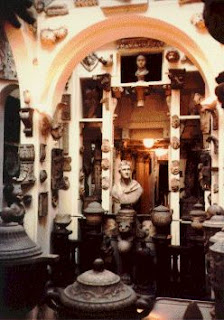This past week I have been laid up in bed with a horrible throat, chest and ear infection, which knocked me for six! Only now have the antibiotics kicked in which have enabled me to get up and actually come and check my e-mail etc... During this time I have, however, been able to think about how lucky we are in the 21st Century to have the wonders of modern medicine to be thankful for, compared to our ancestors.
In the current situation I find myself in I have to thank Alexander Fleming (1881-1955) who discovered during his research of the antibiotic, Penicillin in 1928. But, who else do we have to thank for medical wonders that we, today, take for-granted? Thanks to Louis Pasteur's work we would not have Joseph's Lister's pioneering work on antiseptic surgery, and the discovery of chemical disinfectants, that was inspired by Pasteur. Lister in fact lived out the rest of his days in the South East of England at Walmer in Kent.
 |
| Alexander Fleming |
A born and bred son of Kent who is famous in the medical world, was William Harvey (1578 - 1657). Harvey was born in Folkestone, and you can still see his statue on The Leas today, or even visit The William Harvey Hospital in Ashford. Harvey was the first in 1628 to publish his description of the circulation of the blood around the human body. He also had the prestigious honour of being a physician to King James I.
 |
| William Harvey statue in Folkestone, Kent |
Another man who should be mentioned is Sir James Simpson, a Scottish physician, who in the 1840s pioneered the use of painkillers, most specifically the use of chloroform vapour to ease childbirth. The use of chloroform in this regard was not taken seriously until Queen Victoria herself used this during the birth of Prince Leopold in 1853.
Before this explosion in Victorian medical inventions and discoveries, if you were ill or seriously hurt, you really did not have many options, either for pain relief or the reliability of your doctor/surgeon. Going back in time to the middle ages it was often Monks who were relied upon in medical situations. They were one of the few sections of society who could read the medical literature that was out there, mainly written by Arab scholars to start with. If you weren't lucky to live near a monastery or religious community then really you relied on word of mouth, the experience of others, and old wives tales. For hundred's of years our ancestors relied on a mix of pagan, religious and scientific beliefs to cure all sorts of ailments. Plants and flowers were often used in cures. And there is certainly some truth to some of the remedies - such as chewing cloves for toothache.

In 1215 the Pope declared that Monks should stop treating the sick and that peasants should learn to treat themselves. I think a farmer's knowledge of cattle castration, really didn't qualify them for operations, but this is who the poor had to rely on! Local barbers would not only cut your hair and trim your beard, but take your teeth out for you as well if you wanted, as well as other surgical procedures such as removal of cataracts! Of course there are many tales of Quack Doctors, who were those who saw a way of making some money on the back of the ignorance and desperation of other. However, only a small section of society could afford a qualified doctor, but even if one did pay for a doctor, it did not guarantee you your recovery! Much medicine was trial and error!
 |
| Hippocrates |
The influence of the Greeks on medicine cannot be ignored, for centuries the Hippocratic Method was pretty much standard across Europe. Bloodletting either by opening a vein or using leeches was said to cure people of their problems, as each illness related to one of the "Four Humours" that Aristotle and Hippocrates believed the human body was divided into - this was blood, phlegm, yellow bile and black bile, and all should be in balance. If you were ill, your body was out of balance and as such needed to be purged of the Humour that was affecting it. Another "cure all" prescribed to many was the highly toxic element of Mercury, often used to help with venereal diseases well into the 18th Century.
There really wasn't any painkillers as we know today - people tried various herbs and plants such as hemlock or opium poppies, to help with the pain, however you hoped that you would either pass out from the pain, or perhaps be drunk before surgery was performed. The Herb Garret Old Operating Theatre discovered opposite St Thomas' Hospital in London, really brings to life the reality of medicine and surgery in the early 19th Century, just before anaesthesia. There are even wooden blocks solidly chomped into by the poor people who were operated on over the years - give to them to help them with the pain and to prevent them crying out.
 |
| Old Operating Theatre, London |
In Samuel Pepys' diary, written in the 17th Century, Pepys' gives us a very vivid account of his own bladder stone operation in 1658, which tells in excruciating leg crossing detail what he went through. Even prehistoric finds have shown signs of surgery - there are a number of examples of trepanning, a technique that was used to alleviate any pressure on the brain, by drilling a hole through the top of the head! Ouch! Some of these very early skulls, do however, show signs that the person survived and healed. Amazing.
 |
| Evidence of Trepanning on ancient skull |
Local and national Nursery Rhymes, old wives tales and folk stories also inform us of people's attitudes/remedies etc...to illness. The nursery rhyme "Ring a Ring o' Rosies" is believed to relate to either the Bubonic Plague or the Pox. Certainly people did hold posies of flowers and herbs to their noses to disguise awful smells, and perhaps also to prevent the passing on of disease. Even in the last century, my grandfather still believed that a good dollop of goose fat on the chest when one had a cold really helped!
On reflection of everything, it certainly makes me very grateful for the continuing innovations in science and medicine today! Hope you enjoyed this blog entry, and do let me know of any "home" remedies or tales of medicine that interest you.














